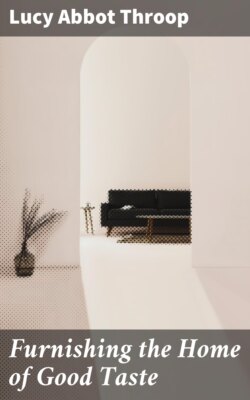Читать книгу Furnishing the Home of Good Taste - Lucy Abbot Throop - Страница 4
На сайте Литреса книга снята с продажи.
Preface
ОглавлениеTable of Contents
To try to write a history of furniture in a fairly short space is almost as hard as the square peg and round hole problem. No matter how one tries, it will not fit. One has to leave out so much of importance, so much of historic and artistic interest, so much of the life of the people that helps to make the subject vivid, and has to take so much for granted, that the task seems almost impossible. In spite of this I shall try to give in the following pages a general but necessarily short review of the field, hoping that it may help those wishing to furnish their homes in some special period style. The average person cannot study all the subject thoroughly, but it certainly adds interest to the problems of one's own home to know something of how the great periods of decoration grew one from another, how the influence of art in one country made itself felt in the next, molding and changing taste and educating the people to a higher sense of beauty.
It is the lack of general knowledge which makes it possible for furniture built on amazingly bad lines to be sold masquerading under the name of some great period. The customer soon becomes bewildered, and, unless he has a decided taste of his own, is apt to get something which will prove a white elephant on his hands. One must have some standard of comparison, and the best and simplest way is to study the great work of the past. To study its rise and climax rather than the decline; to know the laws of its perfection so that one can recognize the exaggeration which leads to degeneracy. This ebb and flow is most interesting: the feeling the way at the beginning, ever growing surer and surer until the high level of perfection is reached; and then the desire to "gild the lily" leading to over-ornamentation, and so to decline. However, the germ of good taste and the sense of truth and beauty is never dead, and asserts itself slowly in a transition period, and then once more one of the great periods of decoration is born.
There are several ways to study the subject, one of the pleasantest naturally being travel, as the great museums, palaces, and private collections of Europe offer the widest field. In this country, also, the museums and many private collections are rich in treasures, and there are many proud possessors of beautiful isolated pieces of furniture. If one cannot see originals the libraries will come to the rescue with many books showing research and a thorough knowledge and appreciation of the beauty and importance of the subject in all its branches.
I have tried to give an outline, (which I hope the reader will care to enlarge for himself), not from a collector's standpoint, but from the standpoint of the modern home-maker, to help him furnish his house consistently—to try to spread the good word that period furnishing does not necessitate great wealth, and that it is as easy and far more interesting to furnish a house after good models, as to have it banal and commonplace.
The first part of this little book is devoted to a short review of the great periods, and the second part is an effort to help adapt them to modern needs, with a few chapters added of general interest to the home-maker.
A short bibliography is also added, both to express my thanks and indebtedness to many learned and delightful writers on this subject of house furnishing in all its branches, and also as a help to others who may wish to go more deeply into its different divisions than is possible within the covers of a book.
I wish to thank the Editors of House and Garden and The Woman's Home Companion for kindly allowing me to reprint articles and portions of articles which have appeared in their magazines.
I wish also to thank the owners of the different houses illustrated, and Messrs. Trowbridge and Livingston, architects, for their kindness in allowing me to use photographs.
Thanks are also due Messrs. Bergen & Orsenigo, Nahon & Company, Tiffany Studios, Joseph Wild & Co. and the John Somma Co. for the use of photographs to illustrate the reproduction of period furniture and rugs of different types.
